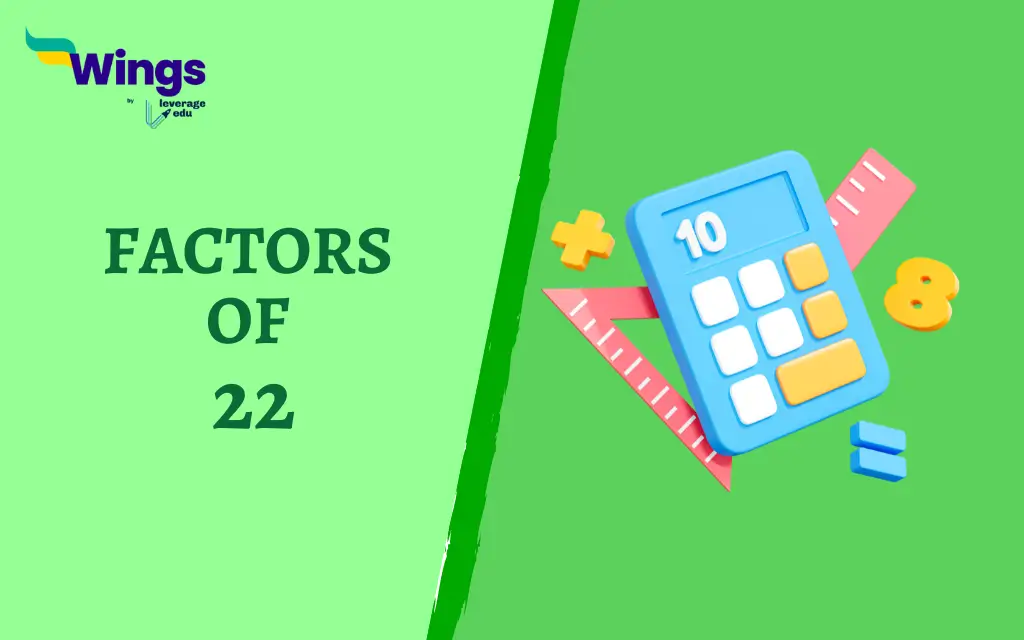In the world of mathematics, Factors have an important part to play. They are the building blocks that help you understand how numbers can be broken down and reassembled via multiplication and division. In this blog, you will learn about the Factors of 22, the Factors of Negative 22, the Factor Tree, Factor Pairs and Factors of 22 by Division Method.
What are the four Factors of 22?
A Factor of a number is any integer that divides evenly into that number without leaving any remainder. Thus, when you talk about the Factors of 22, you are looking for the whole numbers that can be perfectly divided by 22.
After some exploration, you discover that 22 has only four factors which are 1, 2, 11, and 22 itself.
- 1 x 22 = 22 (any number divided by 1 is itself)
- 2 x 11 = 22 (breaking down 22 into two smaller wholes)
- 22 ÷ 1 = 22 (dividing 22 by itself results in 1)
- 22 ÷ 22 = 1 (dividing 22 by itself results in 1, the other way around)
Therefore, these four numbers which are 1, 2, 11, and 22, are the only whole numbers that satisfy the definition of Factors for 22.
Also Read: Factors of 10: Factor Tree, Division Method, Factor Pairs
What are the Factors of Negative 22?
The concept of Factors applies to negative numbers as well. When you use the same principle, the Factors of negative 22 are all the whole numbers that divide evenly into -22.
Thus, the Factors of negative 22 are exactly the factors of 22 which are -1, -2, -11, and -22.
Moreover, here is the reasoning:
(−22) ÷ (−1) = 22 (negative divided by negative is positive)
(−22) ÷ (−2) = 11 (negative divided by negative is positive)
(−22) ÷ (−11) = 2 (negative divided by negative is positive)
(−22) ÷ (−22) = 1 (negative divided by negative is positive)
Hence, both positive 22 and negative 22 share the same set of factors which are -1, -2, -11, and -22.
Also Read: Factors of 15, Division Method, Factor Pairs and more!
What is the Factor Tree of 22?
A Factor tree is a graphical tool that helps you represent the factors of a number in a hierarchical way. Moreover, the Tree compares to an actual tree, with the number itself at the top and its factors branching out below.
For 22, as it is not a Prime Number (a number divisible only by 1 and itself), you can break it down further.
Here is how the Factor tree of 22 looks:
22
/ \
11 2
The tree shows that 22 can be divided into 11 and 2. However, you cannot break down 11 and 2 any further as both are Prime numbers.
Also Read: Factors of 16: Negative Factors, Factor Tree, Pairs and Division Method and more!
Factors of 22 in Pairs
Furthermore, another fascinating way to look at factors is in Pairs. Every Factor of a number has a “partner” that, when multiplied together, somehow results in the original number.
For 22, you can see this pairing:
- 1 x 22 = 22
- 2 x 11 = 22
- -1 x -22 = 22 (considering negative factors)
- -11 x -2 = 22 (considering negative factors)
Moreover, getting to know Factors in Pairs can help solve problems involving multiplication, division, and finding the HCF of two numbers.
Also Read: Factors of 21: Logic, Sum, Negative Factors, Factor Pairs and more!
Factors of 22 by Division Method
There is also a more manual way to find the Factors of 22, and that is via the systematic Division Method. In addition, here is how it works:
- Begin with 1. It divides into 22 with no remainder (1 x 22 = 22), so 1 is a factor.
- Then try dividing by 2. This also goes into 22 evenly (2 x 11 = 22), making 2 another factor.
- Keep trying to increase whole numbers. You will find that 3, 4, 5, and so on, all leave a remainder when divided by 22.
- We reach 11, and it divides perfectly into 22 (11 x 2 = 22). So, 11 is also a factor.
- Since 22 is a relatively small number, you can quickly see that there are no more factors beyond 1, 2, 11, and 22 itself.
Thus, this Division Method involves trial and error, but it can be a good way to solidify your answers.
Related Blogs
I hope this helps! Did you like learning about the Factors of 22? You also learn about the Factors of 1 to 25! Also, keep reading our blogs to learn more about the Basic Concepts of Maths!
 One app for all your study abroad needs
One app for all your study abroad needs














